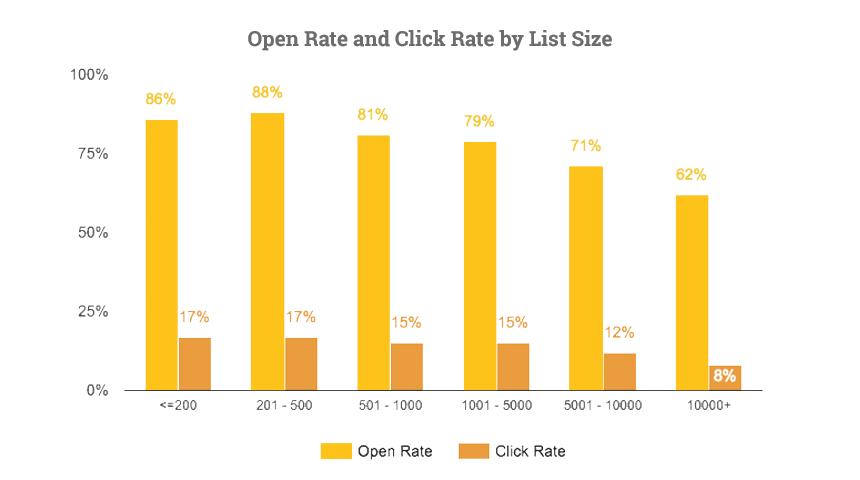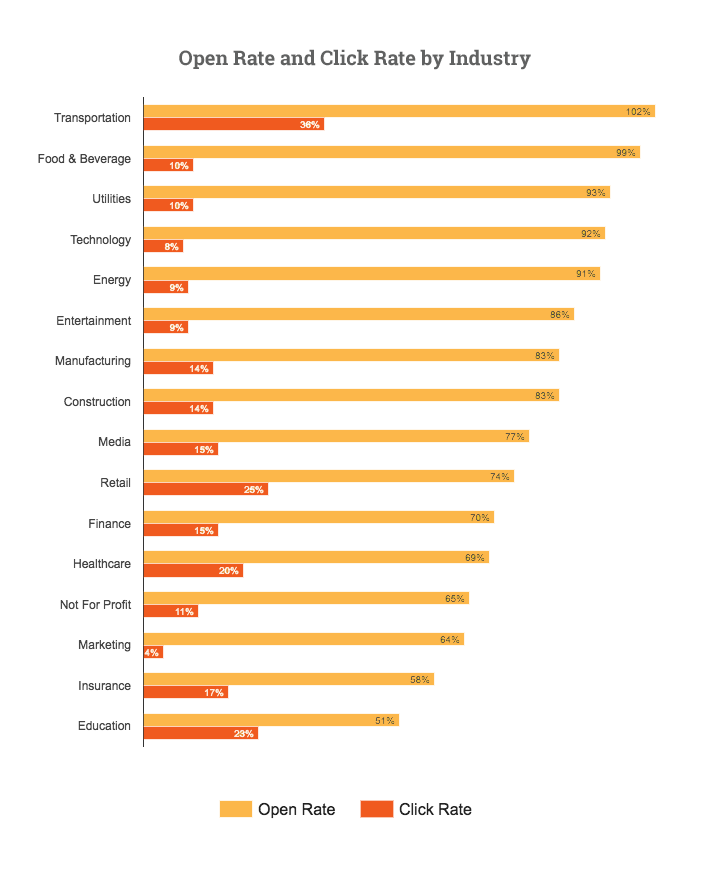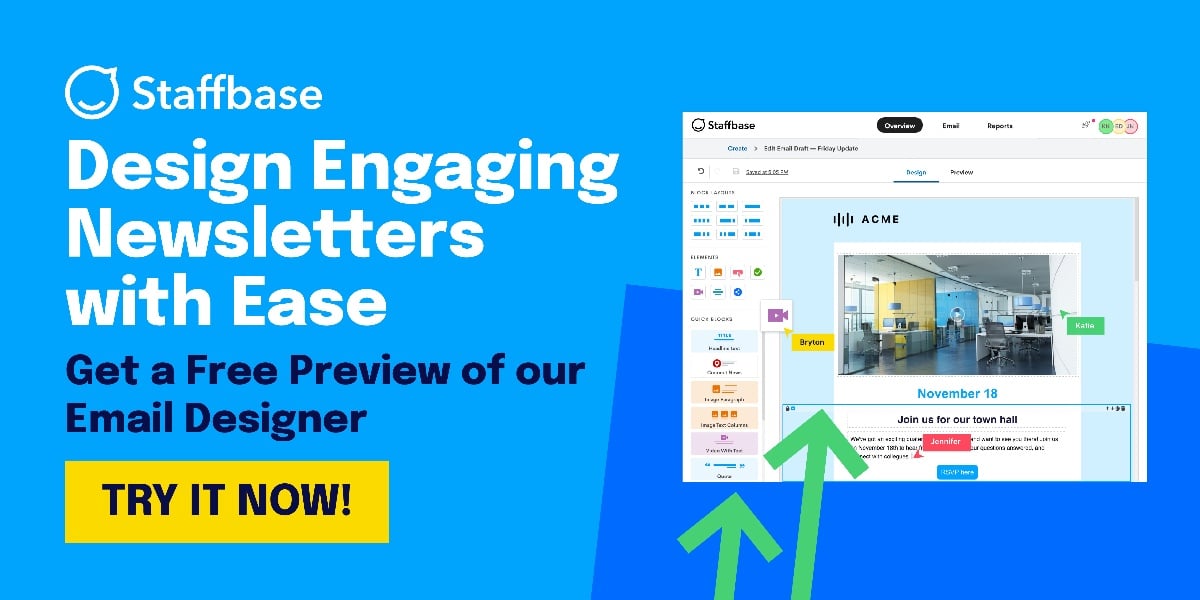How Industry and Employee List Size Impact Internal Engagement Rates

When it comes to benchmarks for employee email engagement, there isn’t a lot of data available out there.
And when you are trying to develop an internal comms email strategy, benchmarking can be helpful for understanding how your company is performing compared to others in your industry and companies of a similar size.
So we set out to discover and set email open and click benchmarks for internal communications. To start, we had our data-analyst masterminds look at 26 million internal email interactions.
We did this so internal communicators can begin to understand their data on a larger scale and in relation to those in their industry and those companies of a similar size.
But more importantly, we wanted to show communicators a different way of thinking about their data. Industry and list size benchmarks are useful only insofar as you are able to make logical assumptions or explain why there may be differences between one set of data (or industry) and the next.
Data is king, but simply comparing your data to benchmarks has limited use if you can’t explain why they are different. It requires a shift in thinking from simply comparing numbers to understanding the story behind the numbers and how you can influence them.
To start, let’s take a look at the numbers.
How does list size affect internal email open rates?
Organizations that send to list sizes of 1,000+ employees seemed to have a tougher time getting employees opening and reading communications. In our research, we found that these larger distribution lists had a relatively lower average of opens and clicks than smaller list sizes, with open rates falling below 80% and click rates below 15%.
On the flip side, smaller list sizes saw more success with opens. Companies with less than 1,000 employees on a given distribution list had open rates over 80%, with fairly strong click rates of 17%.

Why do larger list sizes have lower email opens and engagement?
There are a few reasons why larger distribution lists might be seeing lower opens and click rates.
First, the list size may be so large that some of the internal emails that are being sent on a regular basis don’t apply to everyone. If employees are getting company-wide emails or emails sent to a lot of people, chances are the content isn’t customized to their role or department.
If this is the case, they have a less immediate reason to interact with said content. If they notice these emails over time haven’t been relevant to them, they may stop opening them.
Further, if your distribution list is over 1000 employees, chances are there are segments of the workforce in that list that:
Are not working normal office hours;
Are not working in the same time zone; or
Don’t always have access to their emails.
If this is the case, poorly timed emails may be overlooked, buried in their inbox, or missed completely because employees aren’t working on a regular schedule.
It’s also possible that the list size has less to do with the correlation to opens and clicks than the actual company size.
Smaller companies are naturally going to have smaller list sizes. It’s possible that the higher clicks and opens on smaller list sizes aren’t necessarily due to the size of the distribution list, but the size of the company and their immediate engagement with their employees.
This would mean that if you are at a very large company, segmenting your list may not actually result in more opens. But as an internal communicator, it is important for you to test and evaluate the data and results for yourself.
Segmenting internal email distribution lists
The internal communicators we have talked to say that they have been able to increase their opens and clicks by segmenting their distribution lists. Some internal communicators segment lists based on company hierarchy or geography.
For example, in a healthcare organization, you might break up lists into clinical and non-clinical staff members, and leadership. Regardless of your industry, you can tailor each message or newsletter to each list, an find the perfect send time to make sure they have time to read it and engage with it.
The smaller your segmented list, the more opportunity you have to make the information relevant and engaging to particular employees.
Of course, segmentation should never prevent employees from accessing relevant information. This is why segmentation by department, job role, or seniority (i.e. managers) works — the goal is to make the content more relevant for a group of similar employees.
We suggest having a template with the information that everyone needs in the main body, and either cutting the rest that isn’t relevant to a particular list or supplementing with content relevant to that particular segment.
But don’t go overboard.
Balance list segmentation with efficiency—there is a need to have segmentation (ie. geo-location, seniority) and nice to have segmentation (ie. department, job role). Don’t spend too much time further segmenting lists if it isn’t going to serve you or your employees in a meaningful way.
Internal email open and click rates by industry

Healthcare, Non-Profit, Marketing, Insurance, and Education seemed to struggle the most with their internal emails and had the lowest open rates of the industries we analyzed.
Technology, and food and beverage companies, on the other hand, had the highest open rates but some of the lowest click rates of any of industry we analyzed.
Why do both internal email opens and click rates vary so much across industries?
As we hypothesized, and you may have guessed, open and click rates vary quite a bit across industries.
Each industry has its own struggles with communications. Looking at the data is a great place to start analyzing what encourages such high or low open and click rates in each specific industry.
For example, in healthcare and education, employees don’t necessarily keep traditional 9-5 schedules. They have rotating shifts and class schedules, and a ton of important and action-needed emails entering their inboxes each day. As such, company or institution-wide emails may be overlooked and prioritized lower.
Traditionally these fields, as well as nonprofits, are accustomed to doing a lot with less and get a ton of external and internal emails that they have to prioritize. It is possible the low open and click rates for these industries are simply a product of the email culture and extenuating industry circumstances.
On the other hand, in industries like transportation, and food and beverage, an internal email could mean something major like a food recall, or a canceled trip or rescheduled trip. That means opening company emails is critical for employees to do their jobs correctly.
Speculating the reasons why the data shows what it does is an important piece of evaluating data. Industry benchmarks are great for measuring your own benchmarks against, but you need to do further research within your own company to find out why you may not be measuring up.
What other factors could be influencing open and click rates for your internal emails?
Even within industries, there will be variance.
Maybe your healthcare company has a unique internal structure, or your transportation company doesn’t use email to communicate the most important messages. In these cases, the benchmarks will not correlate with your data. But that is because your company is unique — and so is your data.
Your industry’s structure and relationship with email communication and your company size are just two factors that can influence your data. There are plenty of other factors that impact your open and click rates, including:
Audience (Are they used to getting a lot of email? What kind of priority does it take?)
Environment (What are your employees doing that might make them unable to read an email right away?)
Proximity (Are they in the office, down the street, or in a different time zone?)
Mobility (Are they desk-based, in the field, or working from home? Do they have access to their email all day?)
Role (Do they work normal hours and work weeks or do they have rotating shifts? Do they have access to a computer all day?)
Time of Day (Are they being bombarded with other emails, doing a shift change or have they already left work?)
The best way to find out which factors are affecting your open and click rates is to take a look at your own internal email data, gather feedback from employees and run tests to experiment with timing, content, and employee email segmentation.
How should you use industry benchmarks in internal comms?
Industry benchmarks are a good starting point for your own internal comms benchmarks, but they are not the be-all-end-all. Evaluate them in comparison to your own data, but also use them to help you think through what your data is really saying, and how your internal benchmarks will be different based on your unique company structure and culture.
The key to developing a solid internal comms strategy is understanding what causes engagement and open rates to change and how they can be influenced.
The first step is collecting your company’s internal email opens and click rates so you can set your own benchmarks and start analyzing your data.
Don’t have data? Don’t worry, we’ve got you covered. Book a free demo and find out how easy it can be to collect your own data and start creating a better internal comms strategy with Staffbase Email.










